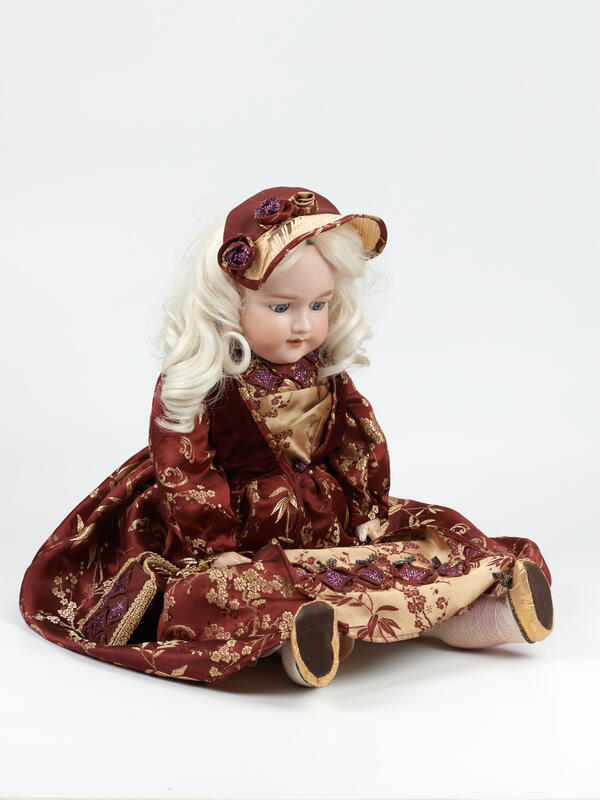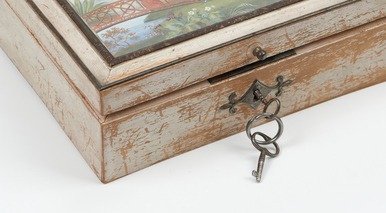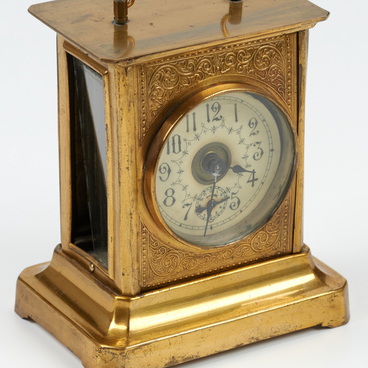The first porcelain dolls in Europe appeared in the 1750s. At first, the figurines were cast in special molds in one piece, then the body was made separately from the head. For the expensive dolls — the highest quality material was used; whereas, the porcelain with a rough surface, called ‘stone bisque’ (‘unpainted bisque’) was used for the cheaper models. Since 1870, the porcelain for doll heads was tinted to look more like skin color. The bodies were made out of leather, wood, textiles, and papier-mache. The sizes of dolls ranged from 6 to 80 centimeters. The hair of the expensive models was made with mohair or natural hair, the hair for the cheaper models was made out of porcelain or painted on the finished head.
The demand for porcelain dolls increased at the end of the 18th — mid-19th century. They were purchased for children or interior decor. Artfully executed models were purchased for private collections. The Armand Marseille factory was popular in Russia at this time. It was founded by Armand Marseille, a son of Russian immigrants. Marseille was born in St. Petersburg. His father was a court architect of Nicholas I, who was fond of German culture and architecture. The Marseille family left Russia after the emperor’s death and settled in the city of Coburg, Thuringia.
Armand Marseille bought a small toy factory in Sonnenberg in 1884, and a year later, he bought a porcelain production factory in Koppelsdorf and modernized it for doll heads manufacturing. Marseille expanded the production over the years, for example, he designed the Queen Louise doll specifically for the American market. He received detailed reports from his representatives in foreign branches, so he could respond to the tastes and demands of any country.
Armand Marseille companies produced about a million dolls and their heads made out of unglazed porcelain. The Marseille company became a doll-making empire with a huge income in the 1900s. Large batches of dolls went to Russia. Armand Marseille always highlighted his origin: there were Russian icons in his house, and he raised the Russian flag over the roof during his social engagements. The children of the last Russian Emperor Nicholas II played with Marseille dolls.
The demand for porcelain dolls increased at the end of the 18th — mid-19th century. They were purchased for children or interior decor. Artfully executed models were purchased for private collections. The Armand Marseille factory was popular in Russia at this time. It was founded by Armand Marseille, a son of Russian immigrants. Marseille was born in St. Petersburg. His father was a court architect of Nicholas I, who was fond of German culture and architecture. The Marseille family left Russia after the emperor’s death and settled in the city of Coburg, Thuringia.
Armand Marseille bought a small toy factory in Sonnenberg in 1884, and a year later, he bought a porcelain production factory in Koppelsdorf and modernized it for doll heads manufacturing. Marseille expanded the production over the years, for example, he designed the Queen Louise doll specifically for the American market. He received detailed reports from his representatives in foreign branches, so he could respond to the tastes and demands of any country.
Armand Marseille companies produced about a million dolls and their heads made out of unglazed porcelain. The Marseille company became a doll-making empire with a huge income in the 1900s. Large batches of dolls went to Russia. Armand Marseille always highlighted his origin: there were Russian icons in his house, and he raised the Russian flag over the roof during his social engagements. The children of the last Russian Emperor Nicholas II played with Marseille dolls.
Elena Vasilchikova donated the doll to the museum collection in 1996. It had belonged to an Ishim merchant Sofia Ludvigovna Kutyreva (Schade) before that, who was Vasilchikova’s great-aunt.



